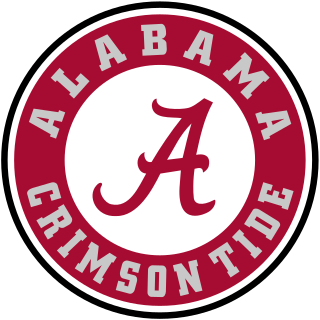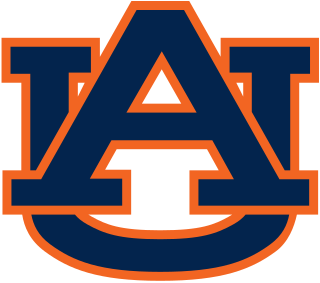Related Research Articles
The 1964 Arkansas Razorbacks football team was an American football team that represented the University of Arkansas in the Southwest Conference (SWC) during the 1964 NCAA University Division football season. In their seventh year under head coach Frank Broyles, the Razorbacks compiled an undefeated 11–0 record, won the SWC championship, closed the regular season with five consecutive shutouts, outscored all opponents by a combined total of 231 to 64, and defeated Nebraska 10–7 in the Cotton Bowl.

The 2003 Alabama Crimson Tide football team represented the University of Alabama in the 2003 NCAA Division I-A football season. It was the Crimson Tide's 69th as a member of the Southeastern Conference (SEC) and its 12th within the SEC Western Division. The team was led by head coach Mike Shula, in his first year, and played their home games at Legion Field in Birmingham and Bryant–Denny Stadium in Tuscaloosa, Alabama. They finished the season with a record of four wins and nine losses.

The 1979 Alabama Crimson Tide football team represented the University of Alabama in the 1979 NCAA Division I-A football season. It was the Crimson Tide's 85th overall and 46th season as a member of the Southeastern Conference (SEC). The team was led by head coach Bear Bryant, in his 22nd year, and played their home games at Bryant–Denny Stadium in Tuscaloosa and Legion Field in Birmingham, Alabama. They finished the season undefeated and with a victory over Arkansas in the Sugar Bowl. For their collective efforts, the Crimson Tide were recognized as unanimous national champions for the 1979 season.
The 1960 Alabama Crimson Tide football team represented the University of Alabama in the 1960 college football season. It was the Crimson Tide's 66th overall and 27th season as a member of the Southeastern Conference (SEC). The team was led by head coach Bear Bryant, in his third year, and played their home games at Denny Stadium in Tuscaloosa and Legion Field in Birmingham, Alabama. They finished with a record of eight wins, one loss and two ties and with a tie against Texas in the Bluebonnet Bowl.

The 1961 Alabama Crimson Tide football team represented the University of Alabama in the 1961 college football season. It was the Crimson Tide's 67th overall and 28th season as a member of the Southeastern Conference (SEC). The team was led by head coach Bear Bryant, in his fourth year, and played their home games at Denny Stadium in Tuscaloosa, Legion Field in Birmingham and Ladd Stadium in Mobile, Alabama. They finished season undefeated with eleven wins, with a victory over Arkansas in the Sugar Bowl and as consensus national champions. The 1961 national championship was the first of the six that Bear Bryant would win as head coach of the Crimson Tide.
The 1962 Alabama Crimson Tide football team represented the University of Alabama in the 1962 NCAA University Division football season. It was the Crimson Tide's 68th overall and 29th season as a member of the Southeastern Conference (SEC). The team was led by head coach Bear Bryant, in his fifth year, and played their home games at Denny Stadium in Tuscaloosa and Legion Field in Birmingham, Alabama. They finished season with ten wins and one loss and with a victory over Oklahoma in the Orange Bowl.
The 1963 Alabama Crimson Tide football team represented the University of Alabama in the 1963 NCAA University Division football season. It was the Crimson Tide's 69th overall and 30th season as a member of the Southeastern Conference (SEC). The team was led by head coach Bear Bryant, in his sixth year, and played their home games at Denny Stadium in Tuscaloosa, Legion Field in Birmingham and Ladd Stadium in Mobile, Alabama. They finished season with nine wins and two losses and with a victory over Ole Miss in the Sugar Bowl.
The 1964 Alabama Crimson Tide football team represented the University of Alabama in the 1964 NCAA University Division football season. It was the Crimson Tide's 70th overall and 31st season as a member of the Southeastern Conference (SEC). The team was led by head coach Bear Bryant, in his seventh year, and played their home games at Denny Stadium in Tuscaloosa, Legion Field in Birmingham and Ladd Stadium in Mobile, Alabama. They finished the season with ten wins and one loss, as SEC champions and with a loss to Texas in the Orange Bowl. As the major wire services at that time awarded their national champions prior to the bowl season, Alabama was also recognized as national champions by the AP and UPI before their loss to Texas. After the bowl games, the Football Writers Association of America (FWAA) named the undefeated Arkansas Razorbacks as the national champions.

The 1965 Alabama Crimson Tide football team represented the University of Alabama in the 1965 NCAA University Division football season. It was the Crimson Tide's 71st overall and 32nd season as a member of the Southeastern Conference (SEC). The team was led by head coach Bear Bryant, in his eighth year, and played their home games at Denny Stadium in Tuscaloosa, Legion Field in Birmingham and Ladd Stadium in Mobile, Alabama. They finished season with nine wins, one loss and one tie, as SEC champions and with a victory over Nebraska in the Orange Bowl. Alabama was also recognized as national champions by the AP Poll after their Orange Bowl win.
The 1966 Alabama Crimson Tide football team represented the University of Alabama in the 1966 NCAA University Division football season. It was the Crimson Tide's 72nd overall and 33rd season as a member of the Southeastern Conference (SEC). The team was led by head coach Bear Bryant, in his ninth year, and played their home games at Denny Stadium in Tuscaloosa, Legion Field in Birmingham and Ladd Stadium in Mobile, Alabama. They finished season undefeated with eleven wins, as SEC co-champions and with a victory over Nebraska in the Sugar Bowl.
The 1954 Alabama Crimson Tide football team represented the University of Alabama in the 1954 college football season. It was the Crimson Tide's 60th overall and 21st season as a member of the Southeastern Conference (SEC). The team was led by head coach Harold Drew, in his eighth year, and played their home games at Denny Stadium in Tuscaloosa, Legion Field in Birmingham, Ladd Stadium in Mobile and at the Cramton Bowl in Montgomery, Alabama. They finished with a record of four wins, five losses and two ties.
The 1957 Alabama Crimson Tide football team represented the University of Alabama in the 1957 college football season. It was the Crimson Tide's 63rd overall and 24th season as a member of the Southeastern Conference (SEC). The team was led by head coach Jennings B. Whitworth, in his third year, and played their home games at Denny Stadium in Tuscaloosa, Legion Field in Birmingham and at Ladd Stadium in Mobile, Alabama. They finished with a record of two wins, seven losses and one tie.
The 1958 Alabama Crimson Tide football team represented the University of Alabama in the 1958 college football season. It was the Crimson Tide's 64th overall and 25th season as a member of the Southeastern Conference (SEC). The team was led by head coach Bear Bryant, in his first year, and played their home games at Denny Stadium in Tuscaloosa, Legion Field in Birmingham and at Ladd Stadium in Mobile, Alabama. They finished with a record of five wins, four losses and one tie. As they finished the season above .500, Alabama secured its first winning season since 1953, and their five victories gave Bryant more wins games in one season than former head coach Jennings B. Whitworth did in previous three.
The 1959 Alabama Crimson Tide football team represented the University of Alabama in the 1959 college football season. It was the Crimson Tide's 65th overall and 26th season as a member of the Southeastern Conference (SEC). The team was led by head coach Bear Bryant, in his second year, and played their home games at Denny Stadium in Tuscaloosa, Legion Field in Birmingham and at Ladd Stadium in Mobile, Alabama. They finished with a record of seven wins, two losses and two ties and with a loss against Penn State in the inaugural Liberty Bowl.
The 1933 Alabama Crimson Tide football team represented the University of Alabama in the 1933 college football season. It was the Crimson Tide's 40th overall and 1st season as a member of the Southeastern Conference (SEC). The team was led by head coach Frank Thomas, in his third year, and played their home games at Denny Stadium in Tuscaloosa and Legion Field in Birmingham, Alabama. They finished the season with a record of seven wins, one loss and one tie, and as the first SEC champions.
The 1934 Alabama Crimson Tide football team represented the University of Alabama in the 1934 college football season. It was the Crimson Tide's 41st overall season and 2nd as a member of the Southeastern Conference (SEC). The team was led by head coach Frank Thomas, in his fourth year, and played their home games at Denny Stadium in Tuscaloosa, Legion Field in Birmingham and the Cramton Bowl in Montgomery, Alabama. They finished the season with a perfect record, as Southeastern Conference champions for the second consecutive season and defeated Stanford in the Rose Bowl.
The 1936 Alabama Crimson Tide football team represented the University of Alabama in the 1936 college football season. It was the Crimson Tide's 43rd overall and 4th season as a member of the Southeastern Conference (SEC). The team was led by head coach Frank Thomas, in his sixth year, and played their home games at Denny Stadium in Tuscaloosa and Legion Field in Birmingham, Alabama. They finished the season with a record of eight wins, zero losses, and one tie.
The 1937 Alabama Crimson Tide football team represented the University of Alabama in the 1937 college football season. It was the Crimson Tide's 44th overall and 5th season as a member of the Southeastern Conference (SEC). The team was led by head coach Frank Thomas, in his seventh year, and played their home games at Denny Stadium in Tuscaloosa and Legion Field in Birmingham, Alabama. They finished the season with a record of nine wins and one loss, as SEC champions and with a loss against California in the 1938 Rose Bowl.
The 1949 Dixie Bowl, part of the 1948 bowl game season, took place on January 1, 1949, at Legion Field in Birmingham, Alabama. The competing teams were the Wake Forest Demon Deacons, representing the Southern Conference (SoCon), and the Baylor Bears, representing the Southwest Conference (SWC). Baylor was victorious in by a final score of 20–7.

The Auburn–Tennessee football rivalry is an American college football rivalry between the Auburn Tigers and Tennessee Volunteers. The game was traditionally played prior to the 1992 football season, when the Southeastern Conference split into its Eastern and Western divisions. Auburn leads the series 29–22–3.
References
- ↑ Foldesy, Jody. "Bowls burgeon as big business", The Washington Times. December 21, 1997. Page A1.
- ↑ "Arkansas drives for late score to nip W&M, 21–19". Richmond Times Dispatch. January 2, 1948. Retrieved April 22, 2022– via Newspapers.com.
- ↑ "Dixie Bowl aftermath". The Birmingham News. January 2, 1948. Retrieved April 22, 2022– via Newspapers.com.
- ↑ "Baylor Bears stop Deacons". The Charlotte Observer. January 2, 1949. Retrieved April 22, 2022– via Newspapers.com.
- ↑ "Baylor grabs 20–7 victory over Deacons". The Birmingham News. January 2, 1949. Retrieved April 22, 2022– via Newspapers.com.